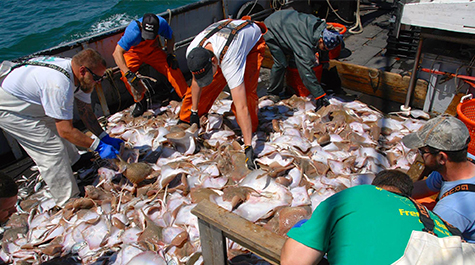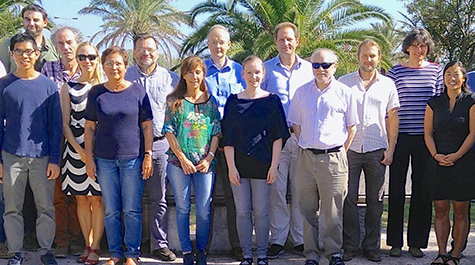VIMS Students Advise International Fisheries
by David Malmquist
Work by graduate students at the Virginia Institute of Marine Science is gaining attention far outside the classroom, as the International Council for the Exploration of the Sea has begun to use methods developed by the students to assess the status of fish stocks worldwide.
Established in Copenhagen in 1902, ICES is a global treaty organization with 20 member countries. Governments and international commissions turn to ICES for advice on marine policy issues, particularly in regards to management of shared, transnational fisheries. ICES partners with industry and scientists to assess the number of fish of a particular species in a particular area—a fish stock. Estimates of stock size are a key driver of fishery-management decisions.
VIMS Professor John Hoenig, who has mentored 4 students involved in developing stock-assessment methods for ICES and other advisory bodies, says, “Our interaction with ICES has been extremely worthwhile, and it’s remarkable it has accepted and used our students’ work to help develop management advice.”
VIMS students Liese Carleton, Quang Huynh, and Kristen Omori have each contributed to ICES during the past few years, either by evaluating generic stock-assessment methods or developing specific methods for a particular stock. Carleton’s efforts focused on Norway lobster, while Huynh focused on North Sea dab, a kind of flounder. Another VIMS student, Lisa Ailloud, has advised ICCAT, the International Commission for the Conservation of Atlantic Tunas, with a focus on bluefin tuna.
Dr. Linda Schaffner, VIMS’ Associate Dean of Academic Studies, says, “It’s nice to see how engaged John’s students have been in this important work. It’s a wonderful opportunity for them, and a wonderful reflection on John’s mentorship and on the quality of student we produce at VIMS.”.
New Course at VIMS
The interaction has been mutually beneficial to such a degree that ICES and Hoenig are now looking to expand it. As part of that effort, Hoenig recently developed a new course-based internship in William & Mary’s School of Marine Science at VIMS titled ICES Stock Assessment Reviews.
Although listed as a summer course, the internship began in April due to an ICES-imposed schedule. It enrolled 8 students: 5 from VIMS, 2 from the University of Miami, and 1 from Florida International University.
During the 18-week course, says Hoenig, “Students first learned about the ICES process for assessing fishery resources and producing management advice, then reviewed special methods for assessing ‘data-limited stocks’—those for which there isn’t a lot of information to inform management.”
The students are now using their knowledge and experience to review the latest assessments for about 50 data-limited stocks comprising about 30 different species, and are now advising ICES as to their acceptability.
“We just finished our first batch of reviews on Baltic stocks, and Lily Hoenig from UM just left for Copenhagen,” says Hoenig. “Next up is a batch of 10 deep-sea stocks, which Liese Carleton from VIMS will review in Copenhagen as well. Then it’s Quang Huynh’s turn, and then Nan Yao from FIU.” The other students—Lisa Ailloud, Kristen Omori, and Cassidy Petersen of VIMS and LaTreese Denson of UM—will present reviews to ICES’ Advice Drafting Groups by webinar.
“It’s a real madhouse,” says Hoenig. “The work has to be done in a rush to meet deadlines, but it is working. The students are getting an eye-opener about the way the real world works, and ICES is getting high-quality labor at very low cost.”
The Data-Limited Puzzle
As budgets allow, government agencies conduct fishery-independent surveys to estimate stock size for species of greatest commercial and ecological importance. The ChesMMAP and NEAMAP programs at VIMS are prime examples in U.S. waters.
Coupling results from scientific surveys with harvest records and knowledge of fish age, growth rates, and natural mortality gives fishery managers ample data to determine a ‘maximum sustained yield’ and set other regulations concerning the number, size, and species of fishes that can be safely harvested from a given area during a given season.
But for many marine fishes, data from one or more of these sources may be meager or lacking. Indeed, ICES puts about 60% of the 260 fish and shellfish stocks for which it provides advice into this data-limited category — including fish of significant commercial interest such as cod, plaice, and turbot.
This is where fishery scientists—and now students at VIMS—come onto the scene. Their job is to generate stock estimates for data-limited species by using mathematical models and statistical techniques to amplify any data that might be available.
Describing prior work by his students Huynh and Carleton, Hoenig says “Quang estimated mortality rates by compiling and analyzing data on the mean length of caught dab, and ICES recommended his technique as an appropriate method for data-limited stocks.”
“Liese applied the mean length-based mortality estimator to several stocks of Norway lobster,” he adds, “and the results were accepted as the basis for ICES’ advice.”
Huynh is now using computer simulations to generate data with known properties and then applying various assessment and management procedures to see which approach or approaches work best. Hoenig says this is “the hot topic in fisheries these days.”
Overall, says Hoenig, “VIMS students are changing the way stock assessments are being conducted by introducing new methods into the stock-assessment process, participating as full members of stock-assessment meetings, and serving as external experts for the review of stock assessments and stock-assessment procedures. They are doing this both in North America and in Europe.”
“It’s a remarkable project,” he adds. “It is still in its infancy but its potential is clear.”
 Skip to main content
Skip to main content


